View in other NatureServe Network Field Guides
NatureServe
Montana
Utah
Wyoming
Idaho
Wisconsin
British Columbia
South Carolina
Yukon
California
New York
Columbia Onion - Allium columbianum
State Rank Reason (see State Rank above)
Known from one occurrence in Camas Prairie. Part of this occurrence has been replaced by a gravelpit. Nearly all suitable habitat in the area has been converted to agriculture. Invasive weeds may also negatively impact the remaining habitat and threaten the population. Survey and monitoring data are needed.
- Details on Status Ranking and Review
Population Size
Score3 - Vey Small: Generally <2,000 individuals.
CommentPopulation size is apparently very small, though exact numbers are uncertain.
Range Extent
Score3 - Local Endemic or Very Small Montana Range: Generally restricted to an area <10,000 sq. miles (equivalent to the combined area of Phillips and Valley Counties) or <6 Sub-basins (4th code watersheds) Range-wide OR limited to one Sub-basin in Montana
Area of Occupancy
Score3 - Very Low: Generally occurring in 3 or fewer Subwatersheds (6th Code HUC’s).
Environmental Specificity
Score1-2 - Moderate to High.
Trends
Score2-3 - Moderate to Severe Declines:
CommentDeclines have taken place as part of one population was impacted by a gravelpit, though the severity of the decline is uncertain.
Threats
Score2-3 - High to Very High.
CommentDevelopment (gravelpit) and invasive species are the primary threats to the species.
Intrinsic Vulnerability
Score0-1 - Low to Moderate Vulnerability.
Raw Conservation Status Score
Score
14 to 18 total points scored out of a possible 19.
General Description
Bulbs globose, solitary or clustered; outer coat membranous, lacking reticulations. Scapes terete, 20–40 cm. Leaves 2, falcate, flat, 3–12 mm wide, persistent. Umbel hemispheric to globose with 20 to 50 flowers; pedicels 6–10 mm long; bracts 3, ovate, apiculate. Flowers rose to magenta; tepals 6–9 mm long; ovary with 6 low, rounded crests; stamens ca. as long as the tepals. Seed surface smooth (
Lesica et al. 2012. Manual of Montana Vascular Plants. BRIT Press. Fort Worth, TX).
Phenology
Flowering in June.
Diagnostic Characteristics
The broad sickle-shaped leaves and swollen stem beneath the inflorescence distinguish it from other species of Allium in our area.
Species Range
Montana Range
Range Descriptions
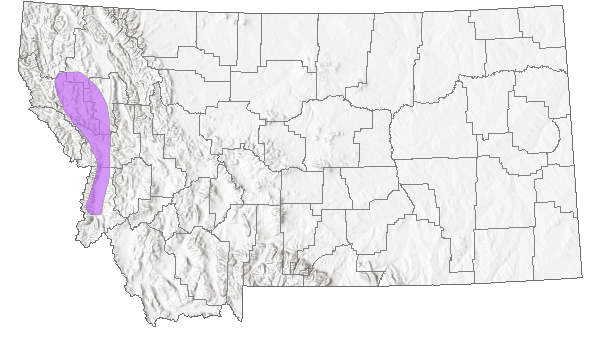
 Native
Native
Range Comments
Regional endemic from eastern WA, northern ID and west-central MT.
Observations in Montana Natural Heritage Program Database
Number of Observations: 13
(Click on the following maps and charts to see full sized version)
Map Help and Descriptions
Relative Density
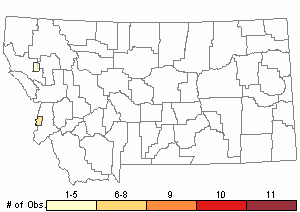
Recency
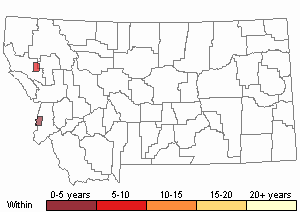

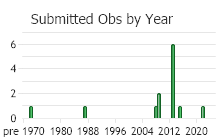
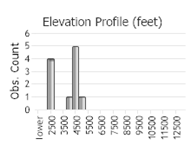 (Observations spanning multiple months or years are excluded from time charts)
(Observations spanning multiple months or years are excluded from time charts)
Habitat
Moist swales and along vernal ponds and streams in the valleys.
Ecology
POLLINATORS The following animal species have been reported as pollinators of this plant species or its genus where their geographic ranges overlap:
Bombus bifarius,
Bombus centralis,
Bombus flavifrons,
Bombus huntii,
Bombus melanopygus,
Bombus sylvicola,
Bombus occidentalis, and
Bombus bohemicus (Macior 1974, Thorp et al. 1983, Colla and Dumesh 2010, Koch et al. 2012, Miller-Struttmann and Galen 2014, Williams et al. 2014).
Stewardship Responsibility
Threats or Limiting Factors
STATE THREAT SCORE REASON
Reported threats to Montana’s populations of Columbia Onion are those that impact its habitat fragments in swales and along wetland margins (MTNHP Threat Assessment 2021). Nearly all of its historic suitable habitat has been converted to agricultural use, and populations remain along the edges of fields, next to roads, or vernally moist forest openings. Populations are exposed to road construction and maintenance, noxious weeds, and trampling by hikers, off-highway vehicles, and horses. Chemical herbicide may also impact plants or populations where noxious species have established. Information on the scope and severity of herbicide application is needed to assess its relative risk to populations.
References
- Literature Cited AboveLegend:
 View Online Publication
View Online Publication Colla, S.R. and S. Dumesh. 2010. The bumble bees of southern Ontario: notes on natural history and distribution. Journal of the Entomological Society of Ontario 141:39-68.
Colla, S.R. and S. Dumesh. 2010. The bumble bees of southern Ontario: notes on natural history and distribution. Journal of the Entomological Society of Ontario 141:39-68. Koch, J., J. Strange, and P. Williams. 2012. Bumble bees of the western United States. Washington, DC: USDA Forest Service, Pollinator Partnership. 143 p.
Koch, J., J. Strange, and P. Williams. 2012. Bumble bees of the western United States. Washington, DC: USDA Forest Service, Pollinator Partnership. 143 p. Lesica, P., M.T. Lavin, and P.F. Stickney. 2012. Manual of Montana Vascular Plants. Fort Worth, TX: BRIT Press. viii + 771 p.
Lesica, P., M.T. Lavin, and P.F. Stickney. 2012. Manual of Montana Vascular Plants. Fort Worth, TX: BRIT Press. viii + 771 p. Macior, L.M. 1974. Pollination ecology of the Front Range of the Colorado Rocky Mountains. Melanderia 15: 1-59.
Macior, L.M. 1974. Pollination ecology of the Front Range of the Colorado Rocky Mountains. Melanderia 15: 1-59. Miller-Struttmann, N.E. and C. Galen. 2014. High-altitude multi-taskers: bumble bee food plant use broadens along an altitudinal productivity gradient. Oecologia 176:1033-1045.
Miller-Struttmann, N.E. and C. Galen. 2014. High-altitude multi-taskers: bumble bee food plant use broadens along an altitudinal productivity gradient. Oecologia 176:1033-1045. MTNHP Threat Assessment. 2021. State Threat Score Assignment and Assessment of Reported Threats from 2006 to 2021 for State-listed Vascular Plants. Botany Program, Montana Natural Heritage Program, Helena, Montana.
MTNHP Threat Assessment. 2021. State Threat Score Assignment and Assessment of Reported Threats from 2006 to 2021 for State-listed Vascular Plants. Botany Program, Montana Natural Heritage Program, Helena, Montana. Thorp, R.W., D.S. Horning, and L.L. Dunning. 1983. Bumble bees and cuckoo bumble bees of California (Hymenoptera: Apidae). Bulletin of the California Insect Survey 23:1-79.
Thorp, R.W., D.S. Horning, and L.L. Dunning. 1983. Bumble bees and cuckoo bumble bees of California (Hymenoptera: Apidae). Bulletin of the California Insect Survey 23:1-79. Williams, P., R. Thorp, L. Richardson, and S. Colla. 2014. Bumble Bees of North America. Princeton, NJ: Princeton University Press. 208 p.
Williams, P., R. Thorp, L. Richardson, and S. Colla. 2014. Bumble Bees of North America. Princeton, NJ: Princeton University Press. 208 p.
- Additional ReferencesLegend:
 View Online Publication
View Online Publication
Do you know of a citation we're missing? Lesica, P., M.T. Lavin, and P.F. Stickney. 2022. Manual of Montana Vascular Plants, Second Edition. Fort Worth, TX: BRIT Press. viii + 779 p.
Lesica, P., M.T. Lavin, and P.F. Stickney. 2022. Manual of Montana Vascular Plants, Second Edition. Fort Worth, TX: BRIT Press. viii + 779 p. Rieseberg, L.H., P.M. Peterson, D.E. Soltis, and C.R. Annable. 1987. Genetic divergence and isozyme number variation among four varieties of Allium douglasii (Alliaceae). American Journal of Botany 74:1614-1624.
Rieseberg, L.H., P.M. Peterson, D.E. Soltis, and C.R. Annable. 1987. Genetic divergence and isozyme number variation among four varieties of Allium douglasii (Alliaceae). American Journal of Botany 74:1614-1624.
- Web Search Engines for Articles on "Columbia Onion"





